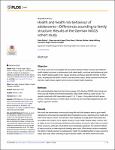Health and health risk behaviour of adolescents—Differences according to family structure. Results of the German KiGGS cohort study
Rattay, Petra
Lippe, Elena von der
Mauz, Elvira
Richter, Felicitas
Hölling, Heike
Lange, Cornelia
Lampert, Thomas
Objective: This study’s aim was to investigate the association between family structure and different health-related outcomes in adolescence (self-rated health, emotional and behavioural problems, health-related quality of life, regular smoking, and heavy episodic drinking). Furthermore, we analysed the extent to which socio-economic status, family cohesion and the pre-transition health status explain family structure-related health disparities. Methods: We used longitudinal data from the first two waves of the German KiGGS cohort study carried out by the Robert Koch Institute (baseline: 2003–2006, follow-up: 2009–2012). The sample comprised 4,692 respondents aged 11 to 17 years. Using data from both waves, effects of family structure on health status at follow-up were calculated applying linear and logistic regression models. Results: We found that adolescents continuously living with both birth parents were in good health. Adolescents whose parents separated after the baseline survey, reported poorer health and were more likely to smoke. The transition from stepfamily to single parent family was also associated with a higher risk of regular smoking. Lower health-related quality of life as well as higher scores for emotional and behavioural problems occurred in almost all non-nuclear family structures, although not all effects were statistically significant. No significant effects of family structure on heavy episodic drinking were found. While family cohesion mediated the effects of family structure on adolescents’ health, the mediating effect of socio-economic status was small. After controlling for pre-transition health, the effects were even lower. Conclusions: Because the direct effects of family structure on adolescents’ health were small and family cohesion was found to be an important mediator in the association between family structure and adolescents’ health, prevention programmes and interventions should be directed towards the parent–adolescent relationship rather than just the family structure, in order to minimize the psychosocial stress of adolescents during the period of family transition.
No license information

